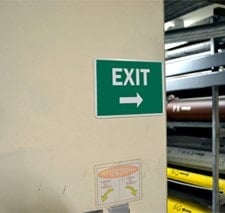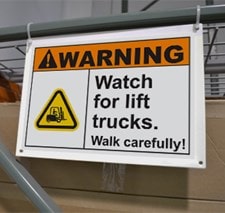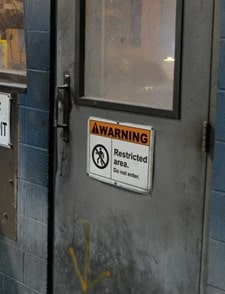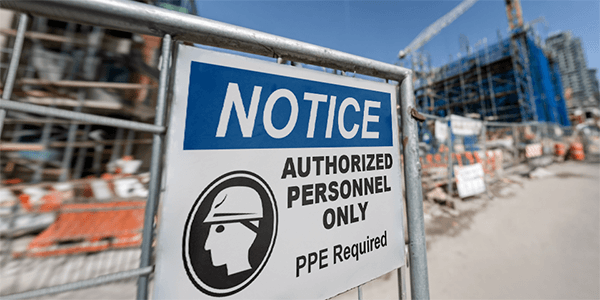Four Types of Wayfinding Signs

Think about the last time you passed through an airport, navigated a highway interchange, or went shopping at the mall. Did overhead signs direct you to your destination? Did text-based messages help you at critical junctures? Were your destinations labeled with images and other visual cues?
These elements are all part of what's called "wayfinding," which creates a system for helping users move throughout an area. Wayfinding relies on a system of signs, signals, and other visual cues to shuttle users from "Point A" to "Point B" in the most efficient manner possible.
If you're looking to develop a wayfinding system for your facility, you'll want to get familiar with the four types of signs at the heart of any good wayfinding system.
In the July 2008 issue of American School & University Magazine, wayfinding expert Ernest Dwight broke down wayfinding into four groups: identification, directional, informational, and regulatory signs. Almost all signs you'll develop as part of a wayfinding system will fall into one of the four groups.
Here's a breakdown of each type of sign:
Identification Signs

As the name implies, identification signs identify where the reader is, and point out specific landmarks or structures. These signs do not provide directions; instead, they may serve as a kind of "you are here" designation or let users know when they've arrived at a destination.
How can you use identification signs around your facility?
- Post signs, using text and images, that identify restrooms, breakrooms, conference rooms, and other common destinations around a facility
- Include "You are here" designations on maps at entryways, where users may first encounter and use your wayfinding system
- Identify entries and exits, and alert users when they enter new areas or buildings within a facility
Directional Signs
 Directional signs are what most people imagine when they think of wayfinding. These signs keep people moving toward their final destination. Directional signs typically appear at junctions or anywhere someone might look for directions. Directional signs may be used at several locations throughout your facility:
Directional signs are what most people imagine when they think of wayfinding. These signs keep people moving toward their final destination. Directional signs typically appear at junctions or anywhere someone might look for directions. Directional signs may be used at several locations throughout your facility:
- Post signs at entries to help visitors find reception desks, offices, loading docks, and other common destinations
- Post signs in elevator lobbies, letting users know which locations can be found on a specific floor
- Display overhead signs at junctions where users may need directions
Informational Signs

Informational signs are less about moving toward a destination than supplementing the trip with useful information along the way. For instance, highway signs may alert drivers when they're entering a construction zone, or warn of upcoming congestion. In both instances, drivers can take that information into account and make or change plans accordingly.
Here's how informational signs can help your facility:
- Let drivers know which parking spots are reserved for visitors or employees
- Caution workers that forklifts may be present
- Let users know where (and how) they can access more information about the facility (such as at a reception desk or informational display)
- Alert visitors when a conference room or meeting area has free Wi-Fi
Regulatory Signs

Regulatory signs inform users of regulations and requirements that are in place. Most drivers will recognize speed limit signs and "No Parking" notices as regulatory signs.
What do regulatory signs look like around a facility? Here's a look:
- Remind users to wear proper PPE, such as hearing protection or face shields, while working around certain equipment or chemicals
- Let users know where smoking is or isn't allowed in a facility
- Warn visitors and workers when certain areas are off limits
- Post speed limits for forklifts
Wayfinding Solutions from Graphic
Products
Duralabel carries sign-making equipment and supplies to help you communicate key messages and help users find their way throughout facilities large and small. DuraLabel industrial sign and label printers come with label creation software, which lets users customize signs with a library of more than 1,800 symbols, and we offer numerous supplies for site-specific applications.
We also offer sign blanks to help you turn labels into rigid signs. Sign blanks come in various materials including plastic, aluminum, steel, fiberglass, and corrugated plastic, and are available in 1-way, 2-way, and 3-way formats for easy viewing from multiple angles.
Related Resources

Industrial Safety Labels | Label Signage | Sign Label
The accurate interpretation of safety signs is crucial to prevent injuries and save lives. OSHA has set ...
Read
All EHS Managers Want for Christmas is ...
A list of safety supplies and other gifts that keep on giving for EHS managers. The holidays are here. ...
Read
5 Industries that Benefit from Custom Industrial Safety Signs and Why
Why Are Custom Industrial SafetySigns Essential for Protecting Workers? In every high-risk workplace, silent ...
Read.png)





